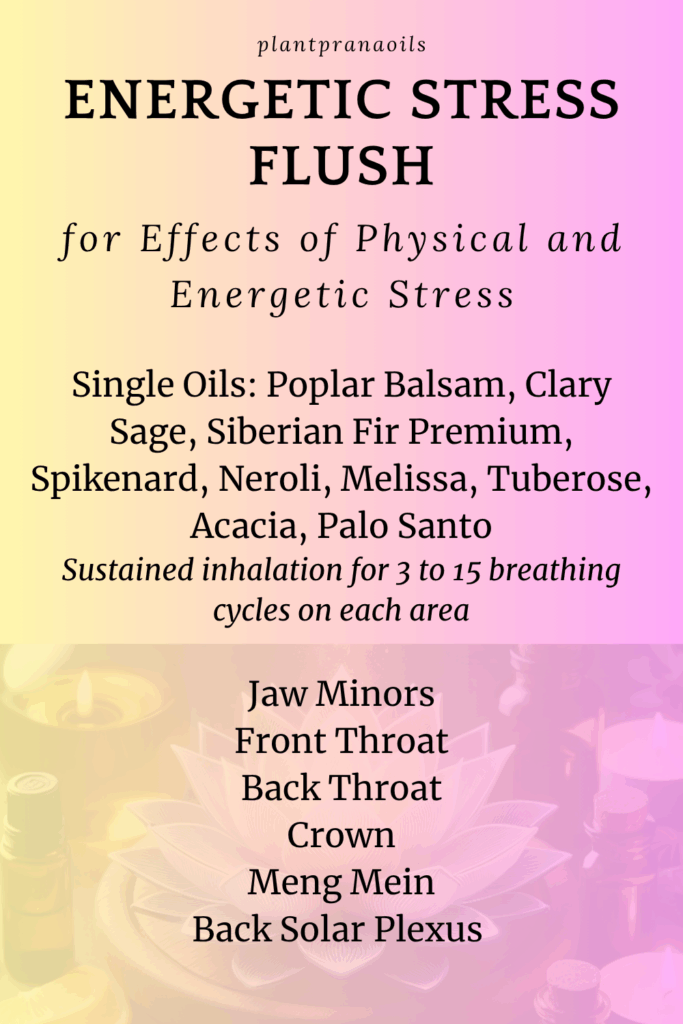Your cart is currently empty!
Want to know more...
Sign up for oil and class updates.

The concept of emotional current refers to the flow of emotional energy within an individual, between people, or in a broader, more universal context. It is the dynamic movement and exchange of emotional energy that can influence a person’s mood, behavior, and overall state of being. Emotional currents are not only psychological but also have a physiological, energetic, and spiritual component, as they shape and are shaped by our thoughts, feelings, beliefs, and interactions with others.
Regulating the emotional current
Applications: Sustained inhalation, Body Tonic, Salt Bath
Poplar Balsam, Siberian Fir Premium
Universal Healer, Avalokitesvara
Sustained inhalation for 3 to 15 breathing cycles on each area
Jaw Minors
Throat
Back Throat
Sex Chakra
Meng Mein
Front Solar Plexus
Back Heart
Brain
Crown
1. Psychological Explanation of Emotional Current
From a psychological standpoint, an emotional current refers to the movement of emotions within an individual’s mindand body, and how those emotions influence one’s thoughts, behaviors, and interactions.
1.1. Flow of Emotions
1.2. Emotional Energy and Thought Patterns
2. Energetic Explanation of Emotional Current
From an energetic or subtle body perspective, emotional currents refer to the flow of energy through the energy centers of the body, such as the chakras, and the aura. These currents of emotional energy influence a person’s energy field and can have a direct impact on their physical health and spiritual well-being.
2.1. Chakras and Emotional Currents
2.2. The Aura and Emotional Flow
3. Spiritual Explanation of Emotional Current
From a spiritual perspective, emotional currents are closely tied to one’s soul evolution, spiritual growth, and connection to the divine. Spiritual traditions teach that emotions are not just psychological states but are expressions of energy that connect individuals to the universe and to the divine realm.
3.1. Emotional Currents as Spiritual Lessons
3.2. Emotional Currents as Manifestation Tools
4. Interconnection of Psychological, Energetic, and Spiritual Currents
The emotional currents within an individual’s mind, body, and spirit are interconnected, influencing each other in a continuous feedback loop. Here’s how they align:

Energetic Stress Flush:
Single Oils: Poplar Balsam, Clary Sage, Siberian Fir Premium, Spikenard, Neroli, Melissa, Tuberose, Acacia, Palo Santo
Sustained inhalation for 3 to 15 breathing cycles on each area
Jaw Minors
Front Throat
Back Throat
Crown
Meng Mein
Back Solar Plexus
Stress
1. Physiological Effects of Stress
Stress has a well-documented biological impact on the body, activating the sympathetic nervous system and preparing the body for a “fight or flight” response. This can cause several immediate and long-term physiological changes, including:
Increased Heart Rate: Stress triggers the release of adrenaline, which increases the heart rate and prepares the body for quick action.
Elevated Blood Pressure: Stress causes the constriction of blood vessels, leading to an increase in blood pressure, which over time can strain the cardiovascular system.
Increased Cortisol Levels: Chronic stress leads to the persistent release of cortisol, a hormone involved in the stress response. While cortisol is useful for short bursts of stress, prolonged exposure can impair immune function and contribute to conditions like anxiety, depression, weight gain, and immune system suppression.
Muscle Tension: Chronic stress can lead to muscle tightness and pain, particularly in the neck, shoulders, and back, which are common areas for the physical manifestation of stress.
Digestive Disruptions: Stress can affect the digestive system, leading to issues like irritable bowel syndrome (IBS), indigestion, acid reflux, or nausea.
Weakened Immune System: Prolonged stress can suppress the immune system, making the body more vulnerable to infections and illnesses.
2. Energetic Effects of Stress
From an energetic standpoint, stress creates imbalances in the body’s energy system, impacting the flow of life force energy (often referred to as Qi, Prana, or Chi in various traditions). These imbalances can lead to blockages in specific energy centers (such as the chakras) or meridians, which are pathways through which energy flows throughout the body.
Blockages in the Energy Field: Stress can lead to energetic blockages in the aura or energy field, which can prevent the free flow of energy throughout the body. These blockages can manifest as:
Energy Congestion: Areas of the body that are experiencing chronic stress may accumulate stagnant energy, which can lead to physical discomfort or fatigue. This is often experienced in places like the solar plexus (associated with personal power) or the heart chakra (associated with love and emotional balance).
Emotional Energy Blockages: Emotions like fear, anger, and anxiety, often associated with stress, can become trapped in specific areas of the body, resulting in emotional stagnation and an inability to process these emotions healthily. This can make it difficult to move past stressful experiences, creating a cycle of energy blockages.
Emotional Baggage / Unprocessed emotions: Chronic stress can result in an accumulation of unresolved emotions like fear, guilt, shame, and anger. These emotional blockages can weigh down the spirit, creating a sense of heaviness and disconnect from one’s higher self. This accumulated emotional baggage may hinder personal growth, making it difficult to move forward in life.
Emotional Reactivity: People who are consistently under stress may become overly reactive to situations, unable to respond from a place of inner peace. This can lead to exhaustion, emotional burnout, and a spiritual disconnect.
Spiritual Stagnation: Stress can prevent individuals from connecting with their spiritual practices or inner guidance. When the mind is overwhelmed with stress, it becomes harder to engage in practices like meditation, prayer, or energy healing, all of which are essential for spiritual growth and healing. This stagnation may cause a sense of spiritual dryness or disconnection from higher guidance.
Spiritual Crisis: Accumulated stress can also contribute to a spiritual crisis, where an individual questions their purpose, faith, or connection with the divine. This can lead to a sense of meaninglessness or a spiritual void.
Relaxing The Bronchioles:

Relaxing the bronchioles — the small air passages in the lungs — has significant benefits, especially for respiratory health and overall oxygenation. The bronchioles are lined with smooth muscle, and when these muscles are relaxed, airflow improves, allowing for easier breathing and better lung function.
1. Improved Breathing & Oxygen Intake
Wider bronchioles allow more air to reach the alveoli (air sacs), improving oxygen exchange and reducing shortness of breath.
Supports better cellular respiration and energy production throughout the body.
2. Relief from bronchial constriction
Reduces the tightness and restriction seen in:
Asthma
Chronic bronchitis
COPD (Chronic Obstructive Pulmonary Disease)
Allergic reactions
Helps prevent or ease asthma attacks and bronchospasms.
3. Decreased Wheezing & Coughing
Relaxing the bronchioles relieves spasmodic coughing and wheezing, especially in conditions with airway constriction.
Leads to quieter, more effortless breathing.
4. Better Sleep & Reduced Fatigue
Easier breathing at night improves sleep quality, especially for those with nighttime asthma or sleep apnea.
Enhanced oxygenation reduces daytime fatigue and improves mental clarity.
5. Reduced Inflammation & Airway Stress
Relaxation of bronchial muscles can interrupt the cycle of inflammation, spasm, and mucus production.
Supports long-term healing and reduces the risk of chronic airway remodeling in conditions like asthma.
6. Enhanced Athletic Performance & Recovery
Athletes benefit from relaxed bronchioles through:
Improved ventilation efficiency
Reduced breathlessness during exertion
Faster recovery post-exercise
7. Support During Respiratory Infections
In conditions like colds, flu, or pneumonia, relaxing the bronchioles helps clear mucus and reduce discomfort.
Aids in restoring normal breathing patterns during illness.
8. Ripple Effect
Relaxing the bronchioles has a ripple effect across multiple body systems—especially through its influence on oxygenation, the nervous system, and inflammatory responses. While the bronchioles are part of the respiratory system, their relaxation can indirectly affect pain perception, anxiety, inflammation, adrenal function, and cognitive performance. One of the first steps for treating sharp stabbing pain is to reduce bronchial spasms which significantly reduces pain.
Summary of Effects by System
| System/Function | Effect of Bronchiolar Relaxation |
| Pain | Decreases tissue tension and hypoxia-related pain; calms sensory nerves |
| Anxiety | Promotes parasympathetic calm; improves breath control and reduces panic cycles |
| Inflammation | Enhances oxygenation and vagal tone; reduces systemic inflammatory responses |
| Adrenal Function | Reduces stress hormone output; supports HPA axis regulation and adrenal recovery |
| Cognitive Function | Improves oxygen to the brain; reduces neural overactivity and enhances focus, memory, and clarity |
Relaxation of Bronchioles:
1. Tinctures
Choose one of the following-
Coltsfoot: Reduces bronchial spasms, tension, and coughs
1-2 droppers full orally daily in water
Lobelia: Reduces bronchial spasms, relaxes the diaphragm, deepens the breath, and decreases body spasms
1-2 droppers full orally daily in water
2. Essential Oils
Single Oils: Larch
3. Essential Oils
Single Oils: Hyssop, Frankincense, Sitka, Inula, Ammi Visnaga, German Chamomile, Tolu Balsam, Lantana
Sustained Inhalations
4. Ointment (or neat)
Apply Spikenard ointment to the feet at night before bed

Reiki Symbol Blends (used for attunements, and increasing the potency of Reiki empowerments and initiations)
Dai Koo Myo (The Master Symbol)
Ingredients: Sitka, Cistus, Aloes, Frankincense Vital
Dai Koo Myo 5ml and Dai Koo Myo 2ml rollerball
Sei He Ki (Symbol for emotional and Mental Healing)
Ingredients: Benzoin, Thyme Linalool, Patchouli Selatan, Mandarin Petitgrain, St.John’s Wort
Sei He Ki 5ml and Sei He Ki 2ml rollerball
Hon Sha Ze Sho Nen (distant healing)
Ingredients: Bakul, Marjoram, Guggul
Hon Sha Ze Sho Nen 5ml and Hon Sha Ze Sho Nen 2ml rollerball
Cho Ku Rei (Power Symbol)
Ingredients: Spikenard, Aloes, Arnica, Galbanum
Reiki symbols are powerful tools used in the practice of Reiki healing, an ancient Japanese technique that promotes relaxation, stress reduction, and healing through the use of universal life energy. Reiki practitioners use these symbols as part of their healing process to channel energy to others or themselves. Each symbol has its own specific meaning and purpose and is intended to activate different aspects of healing and energy work.
Reiki symbols are typically used by practitioners who have undergone Reiki attunements in which they are “initiated” or “empowered” by a Reiki Master to use the symbols effectively.
1. Cho Ku Rei (Power Symbol)
2. Sei He Ki (Mental and Emotional Healing Symbol)
3. Hon Sha Ze Sho Nen (Distance Healing Symbol)
4. Dai Koo Myo (Master Symbol)
Purpose of Using Reiki Symbols
The Reiki symbols serve several key purposes:
Sustained Inhalation for 3 to 15 breathing cycles
Urinary System Protocol, Advanced

1. Urinary System: Stress
Blend: Urinary Stress Blend
Sustained inhalation for 3-15 breathing cycles
Kidneys
Sex Chakra
Meng Mein
Lower Spine
2. Inflammation / Cortisone Production
Single Oils: Sylvester Pine
Sustained inhalation for 3-15 breathing cycles
Kidneys
Sex Chakra
Meng Mein
Lower Spine
3. Homeostatic Emotion
Single Oils: Helichrysum
Sustained inhalation for 3-15 breathing cycles
Kidneys
Sex Chakra
Meng Mein
Lower Spine
4. Re-education of the nerves
Blend: Nerve Help
Sustained inhalation for 3-15 breathing cycles
Kidneys
Sex Chakra
Meng Mein
Lower Spine